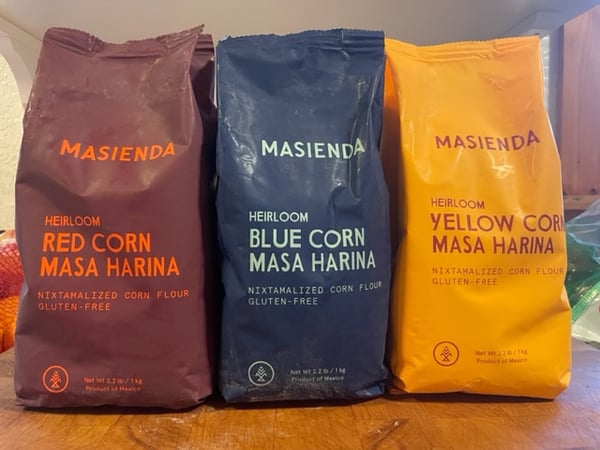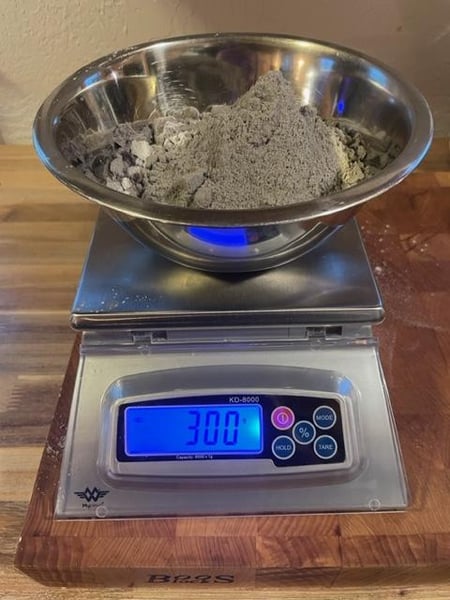Hey folks, have you ever tasted the difference between a typical grocery store corn tortilla, and one made fresh in your kitchen? If you live in Chicago then maybe you haven’t, because why would you? The tortillas available to you in basically every grocery or corner store in the city are so good the need may never arise in one hundred lifetimes.
 However, there is something to be said for making your own tortillas. It's not just the act of making them yourself that biases you toward thinking they’re especially delicious. There will never be a tortilla in as good condition as one cooked freshly. That goes for the excellent grocery store examples as well. A reheated tortilla can be very very good, but it will never be quite as good as it was hot off the comal (or heavy bottomed pan in the case of most of us in our home kitchens).
However, there is something to be said for making your own tortillas. It's not just the act of making them yourself that biases you toward thinking they’re especially delicious. There will never be a tortilla in as good condition as one cooked freshly. That goes for the excellent grocery store examples as well. A reheated tortilla can be very very good, but it will never be quite as good as it was hot off the comal (or heavy bottomed pan in the case of most of us in our home kitchens).
The problem I have always faced when making tortillas at home is finding high quality masa harina. For the uninitiated, masa is the dough made from grinding nixtamalized corn into a fine paste for use in making tortillas, tamales, gorditas, tlayudas, sopes, and many many other wonderful culinary inventions. Masa harina is the dried flour-like product that allows you to make tortillas ready masa by simply adding water.
The most popular brand of masa harina is, by far, Maseca. The Maseca brand is so ubiquitous that many people simply refer to all masa harina as Maseca (much like band-aid, Xerox, or Kleenex). Now, while Maseca makes a perfectly serviceable tortilla, there is some untapped potential here.
Enter: Masienda. This company offers a whole lot more than just masa harina, but their masa harina is what I came for. They make theirs using painstakingly sourced heirloom corn from Mexican farmers, and then process it in such a way that it retains its unique characteristics and flavors from these different corns.
The flavor difference here is extraordinary. The aroma of fresh nixtamal is strong even while still in dry powder form. And once you add water and griddle a fresh tortilla you may never be able to go back. But it isn’t just the flavor that's better. Masienda’s masa harina has improved texture as well. I’ve never felt a masa dough as gummy and elastic (this is a good thing) as that made with the masienda stuff. This allows you to make tortillas that are as soft and pillowy as those you’d find at the most refined Mexican tables.
But don’t take my word for it. Let's take a look at a simple tortilla making technique so you can get some grade A masa harina and try it out for yourself.
 I like to weigh out my starting amount so I know roughly how much water to use, and roughly how many tortillas I’ll get, but it isn’t strictly necessary.
I like to weigh out my starting amount so I know roughly how much water to use, and roughly how many tortillas I’ll get, but it isn’t strictly necessary.
Add water slowly while stirring. You will need roughly 1.4 parts of water (by weight) to 1 part of masa harina.
Once the dough becomes too thick to stir, mix with your hand. Continue adding water until your masa passes the squish test.
To perform the squish test, grab a roughly golf ball sized wad of masa.
Squish it between your palms.
If your squished masa doesn’t crack at the edges, then its properly hydrated. If it does crack, keep adding water little by little until it passes the test.
Here’s a look at the texture of my finished masa.
Portion your masa into balls of roughly 28-30 grams (this will make a roughly 5” tortilla) and roll them into balls using your hands. Wet your hands with water to make handling the masa easier.
Line a tortilla press with two sheets of plastic, or (as I have done) a small zip top bag with all sides sliced open except the bottom.
Place a ball of masa slightly off center towards the press hinge in between the sheets of plastic.
Cover the masa ball with the second sheet of plastic and press it down with your palm until slightly flattened.
Press the tortilla until it is roughly 1.5 millimeters thick.
Gently peel the pressed tortilla off of the plastic sheets.
And place it on a hot (450-650º F) dry (i.e., no oil) pan. Carbon steel or cast iron work best here.
Cook for about 30 seconds on the first side; until lightly golden in spots.
Cook the second side for roughly the same amount of time.
You can’t really see it in this image too well, but if you flip the tortilla over for a second time, and press gently with a spatula or fingers it should puff, assuming the hydration of the masa and heat of the pan are on point.
For the last test to check the quality of your tortilla, do the crumple test. Place the freshly cooked tortilla in your hand
Crumple
And if you can unfurl it without any cracks or breakage then you have succeeded in making a first rate tortilla. Nice work!
If this has inspired you to try making some delicious fillings to go with your new tortilla skills I recommend checking out our upcoming Hands-On Regional Street Tacos on the Patio class coming up on:


